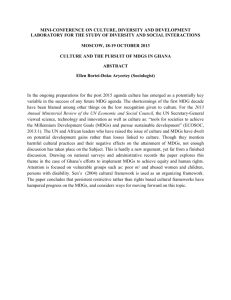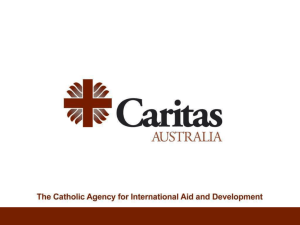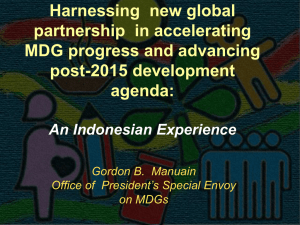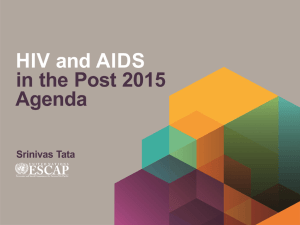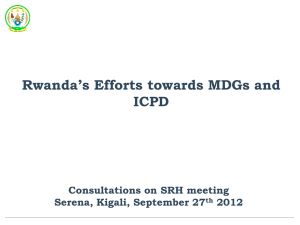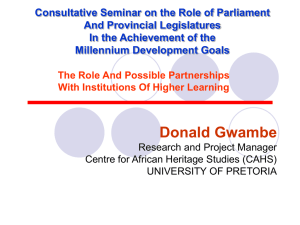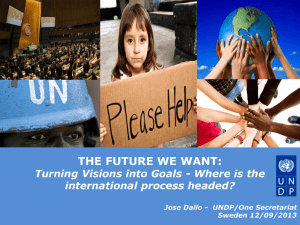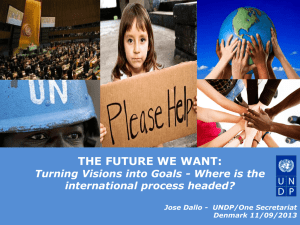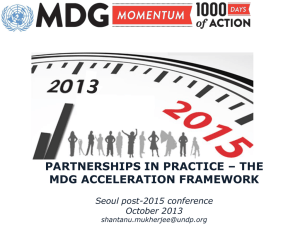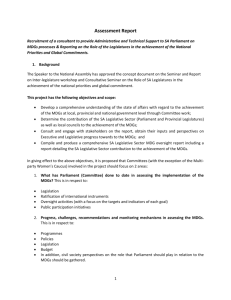Presentation - McGregor Consulting Group
advertisement
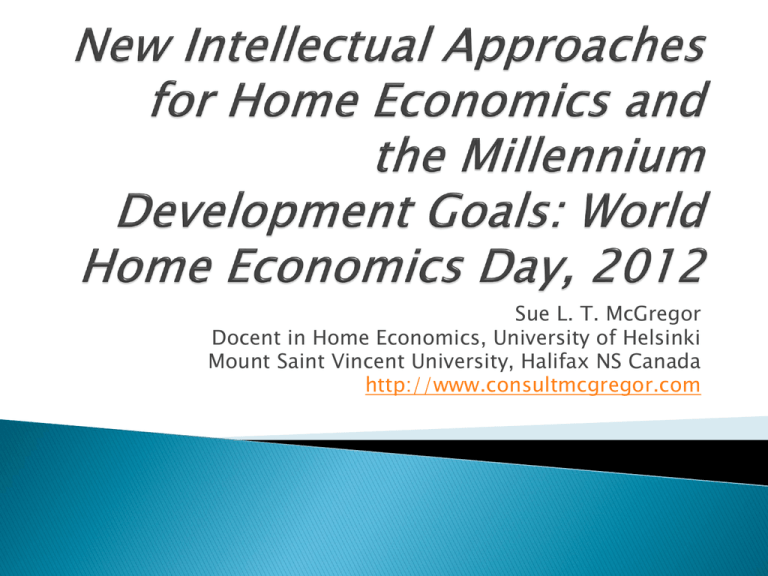
Sue L. T. McGregor Docent in Home Economics, University of Helsinki Mount Saint Vincent University, Halifax NS Canada http://www.consultmcgregor.com It is based on six fundamental values In order to translate these values into actions, it contains five key objectives The UN work agenda (until 2015) involves achievement of eight goals Details about the 21 targets are available at the United Nations MDG website http://www.un.org/millenniumgoals/bkgd.shtml and at the Millennial Project website, commissioned by the UN General Assembly http://www.unmillenniumproject.org/goals/gti.htm Track progress along the 60 indicators http://www.mdgmonitor.org/ The annual state reports are available at http://mdgs.un.org especially at http://mdgs.un.org/unsd/mdg/Host.aspx?Content =Products/ProgressReports.htm UN was formed in 1949. Five years later, IFHE gained consultative status with the FAO and now has same with ECOSOC, UNESCO, UNICEF and with the Council of Europe. It represents the voice of individuals and families in UN policy and programme decisions, and it represents home economics’ interests at the international level In 2011, IFHE published a position paper for each of the eight MDGs: http://ifhe.org/Broc hure_PositionStatements_2011.pdf Without strong families, the MDGs cannot be met or sustained, and families cannot be sustained unless the MDGs are met. always be aware of the local challenges faced by individuals and families while being aware of regional and national policies and commitments that might affect how one addresses these local challenges. the challenges of everyday life are not onedimensional; they are complex, integrated and interwoven. We cannot solve one MDG by ignoring the others because all MDGs impact quality of life; the solution of one MDG involves solving the others. Government refers to the body making policy and governance refers to the processes this body uses to make policy decisions. We must inform these processes from a family perspective. support gender equality while continuing to respect cultural and familial traditions. A critical balance must be obtained between ensuring cultural understandings of what constitutes a family and liberating and empowering all family members, especially girls and women. reiterate the profound contributions that the economy of care brings to meeting the MDGs. Unpaid reproductive work, usually done by women, provides the very foundation for achieving the MDG goals, but tends to be undervalued by most people in governments because it is not paid work (e.g., household maintenance, birthing and raising children, elder care, other family life duties, and volunteer work). promote skills for everyday life as paramount to meeting the MDGs, and lobby for home economics in curricula at all levels (primary, secondary, tertiary and adult/lifelong learning). help people recognize the potential of home economics to help meet the MDGs. We have the ability to recognize MDG-related problems in the household and to bring the voices of everyday life to the policy level. remind policy makers that home economics is about both (a) achieving optimal living and quality of life for families while (b) ensuring sustainability for humanity. Home economics helps people optimize their resource management in sustainable ways, thereby contributing to achievement of the MDGs. DRAW ON OLD APPROACHES TO PRACTICE AND BECOME OPEN TO NEW APPROACHES THAT MIRROR THE MDGS interdisciplinarity practical, perennial problem solving moral value reasoning three systems of actions family and human ecosystems and more… . But, the complex, integrated nature of the MDGs, and the deep-level policy work championed by the IFHE position papers, means we need more COMPLEXITY INTEGRAL THINKING THINKING TRANSDISCIPLINARITY Complexity theory introduces a new set of assumptions that can underpin home economics initiatives: complexity, change and evolution, adaptation, emergence, nonequilibrium, chaos and tensions, patterns and networks, and holistic, synergistic interconnections and relations between individual and aggregate agents. Especially, a self-organizing family system (selfdirected, regroups, reorganizes) increases in complexity without being guided or managed from an outside source. It becomes selfdetermining and empowered Complex Adaptive System (CAS) consists of parts (agents or people) that form a system (team or group) and that system shows complex behaviour while it keeps adapting to a changing environment. Other examples of CAS are brains, bee hives, bacteria, immune systems, the Internet, gardens, cities CAS are complex because of: both stabilizing and reinforcing feedback loops, both multiple and opposing causes per effect, time delays between cause and effect, the property of emergence, and the MANY relationships, both known and unknown that make the CAS unpredictable and complicated In CAS, people are never just observers. Their presence alone influences the system. They can influence the other agents, relationships, environments, boundaries. Complexity theory proposes that in a CAS, the agents constantly act, act with and react to what other agents are doing. The overall behaviour of the complex adaptive system is the result of a huge number of decisions made every moment by many individual agents, acting on local information. It helps us assume that people can self-organize (reorganize and regroup) and change their approach to life and living, especially as they grapple with the global problems reflected in the MDGs: poverty, water and sanitation, schooling, health pandemics, climate change Note that anything that is not constrained will self-organize. This means home economics has to help families become self-directed instead of dependent. Achieving the MDGs depends upon this! Families need to be free to act, not be constrained. An integral vision assumes people will try to touch all bases, try to respect and learn from many perspectives as they problem solve life’s dilemmas, especially those presented by the MDGs I use Ken Wilber’s approach to integral thinking. It is called AQAL – all quadrants, all levels. There are four quadrants to his theory and many, many levels. Today, I focus on the quadrants. http://www.tanasaler.com/ These four perspectives of life stem from the inner self, the physical self, the community, and the collection of world systems. Wilber refers to these as the whole or integral approach to life. It is imperative that people learn to find the patterns that connect all of these four elements instead of falling back on what is comfortable and standing in just one quadrant. Indeed, standing in one quadrant (e.g., the scientific, empirical upper right) results in an imbalanced, flat, one-dimensional approach to life, living, and leadership. The same can be said for viewing an MDG from (a) lower left morality, shared norms, (b) upper left inner-self, artful self-expression, and (c) lower right web of life, complex systems, empirical quadrants. Leaving out any of these quadrants yields an incomplete picture of reality. Too much is missed, compromising one’s ability to deal with the complexity of life. A main assumption of integral thinking is that as soon as people begin looking through the integral lens, everything has the potential to come into focus. Once that lens turns and clicks, people gain clarity and are able to make better decisions for the future. From an integral stance, the goal of home economists would be to help people problem solve in such a way that mind (I), matter (It), meaning (We) and the web of life (Its) are all taken into account, or at least be aware that while acting in one quadrant, the other three realities exist. The intent is to teach people to be as comprehensive, inclusive, and caring as possible, striving for deep clarity of their situation and the wider context. Rather than excluding points of view, people would strive to adopt all views that are useful for dealing with their current dilemma and do so by looking for things they would otherwise ignore The MDGs are complex and interconnected. A complex world requires a complex lens on the world in order to be as inclusive as possible; that is the promise of the integral approach. We are all familiar with the concept of home economics being interdisciplinary. This means we work with and draw from other disciplines, within the university system. Solving the MDGs necessitates taking down the boundaries among many disciplines and between the university system and the rest of the world. This is what transdisciplinarity lets us do – solve the problems of the world faced by all of humanity – as set out in the MDGs emergent and complex, focused on moral obligations and on shared, joint responsibly for the world and each other. Rather than just facts and information, people would be taught to value evolving relationships and to look for patterns of likeminded or divergent thinking In this context, everything is in-formation, changing due to the synergy (energy) created when people jointly problem solve or ponder the nuances and complexities of the 21st century. The complex knowledge that is created is alive, dynamic, forever changing, never static. What counts as reality would expand from just one discipline to include many levels of reality (within and beyond disciplines): economic, political, historical, social, ecological, spiritual, cultural and aesthetic spheres of life. Knowledge and perspectives from all of these spheres is needed to address the MDGs. Solutions to the complex problems reflected in the MDGs are best solved by a meeting of the minds at the borders between these many spheres of reality. In the midst of the tensions inherent in dealing with complex MDG issues along these many levels of reality, order and new insights are always emerging. Instead of understanding chaos as disorder, home economists would teach people that chaos is order emerging. A new respect would be gained for fluctuations, unpredictability, uncertainties and disturbances, appreciating that novel solutions to modern day dilemmas will emerge from the chaos. Instead of exclusive logic, TD uses inclusive logic (the logic of the included middle). The space between things is fertile, alive, in flux and deeply dynamic. It is within this intellectual, inclusive space that people meet, engage, share perspectives, values, feelings, information and develop relationships new TD knowledge perks up and emerges. Energy is created from people bouncing ideas off of each other (intellectual fusion). People have to accept that others have valuable perspectives, which, once heard, can potentially be integrated into new embodied, emergent, complex TD knowledge Different world views and value orientations held by people from many different levels of reality may cause conflict, resulting in power struggles. The complexity of MDGs requires partnerships and knowledge sharing among experts from different academic disciplines (natural, social and human) and from members of civil society. They must be able to talk to each other. The constellation of values at play during the solution of MDG problems must be respected, managed and led because every utterance will be valueladen. Home economists would be unique in their complexity, integral, transdisciplinary approach to achieving the MDGs from a family perspective. We could become the go-to discipline and profession for insights into how governments’ can honor their MDG commitments, now and beyond 2015. IFHE can continue to be on the vanguard if this world-wide home economics initiative.
